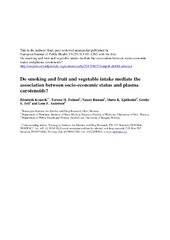Do smoking and fruit and vegetable intake mediate the association between socio-economic status and plasma carotenoids?
Kvaavik, Elisabeth; Totland, Torunn Holm; Bastani, Nasser Ezzatkhah; Råberg Kjøllesdal, Marte Karoline; Tell, Grethe Seppola; Andersen, Lene Frost
Peer reviewed, Journal article
Accepted version
Permanent lenke
https://hdl.handle.net/1956/10576Utgivelsesdato
2014Metadata
Vis full innførselSamlinger
Originalversjon
https://doi.org/10.1093/eurpub/ckt081Sammendrag
Background: The aim was to study whether the association between educational attainment and antioxidant status is mediated by smoking and fruit and vegetable intake. Methods: Cross-sectional analyses of the Oslo Youth Study 2006 wave were carried out. Information about education, smoking habits and diet was collected by questionnaire for 261 subjects (142 women and 119 men aged 38–42 years). Blood samples, height and weight measurements were taken by the participants’ General Practitioner. Blood were analysed for plasma carotenoids. Linear regression analyses were used to examine whether smoking and fruit and vegetable intake mediate the association between education and plasma carotenoids. Results: Educational level was positively associated with β-cryptoxanthin, α-carotene and lutein/zeaxanthin, but not with total carotenoids, β-carotene or lycopene. Education was negatively associated with smoking and positively associated with fruit and vegetable intake. Smoking was negatively associated with β-cryptoxanthin, and fruit and vegetable intake was positively associated with β-cryptoxanthin (adjusted for educational level). Moreover, cigarette consumption mediated the association between education and β-cryptoxanthin by 37%, while fruit and vegetable intake mediated this association by 18%. The total mediation effect was 55%. Conclusion: Smoking seemed to be more important as a mediator between education and plasma levels of β-cryptoxanthin than the intake of fruit and vegetables, but more studies are needed to establish the relative importance of smoking and diet as mediators of the association between education and antioxidant status.
